Management of Change: HMRC, Ontology and Epistemology Analysis
VerifiedAdded on 2020/04/07
|21
|5657
|59
Report
AI Summary
This report delves into the complexities of change management, focusing on theoretical perspectives such as ontology and epistemology. It examines the role of a change agent within an organization, using HMRC as a case study. The report explores the identification of change, a SWOT analysis, and key conceptualizations of the change agent's role. It further discusses problem-centric and dialogic approaches to change, providing a comprehensive analysis of how organizations can navigate and implement change effectively. The report considers different modes of reality (material, artefactual, social, and ideal) and epistemology (linear and non-linear) to understand the nature of knowledge and the impact of change processes. The assignment also touches on the importance of communication, feedback, and stakeholder engagement in successful change initiatives.
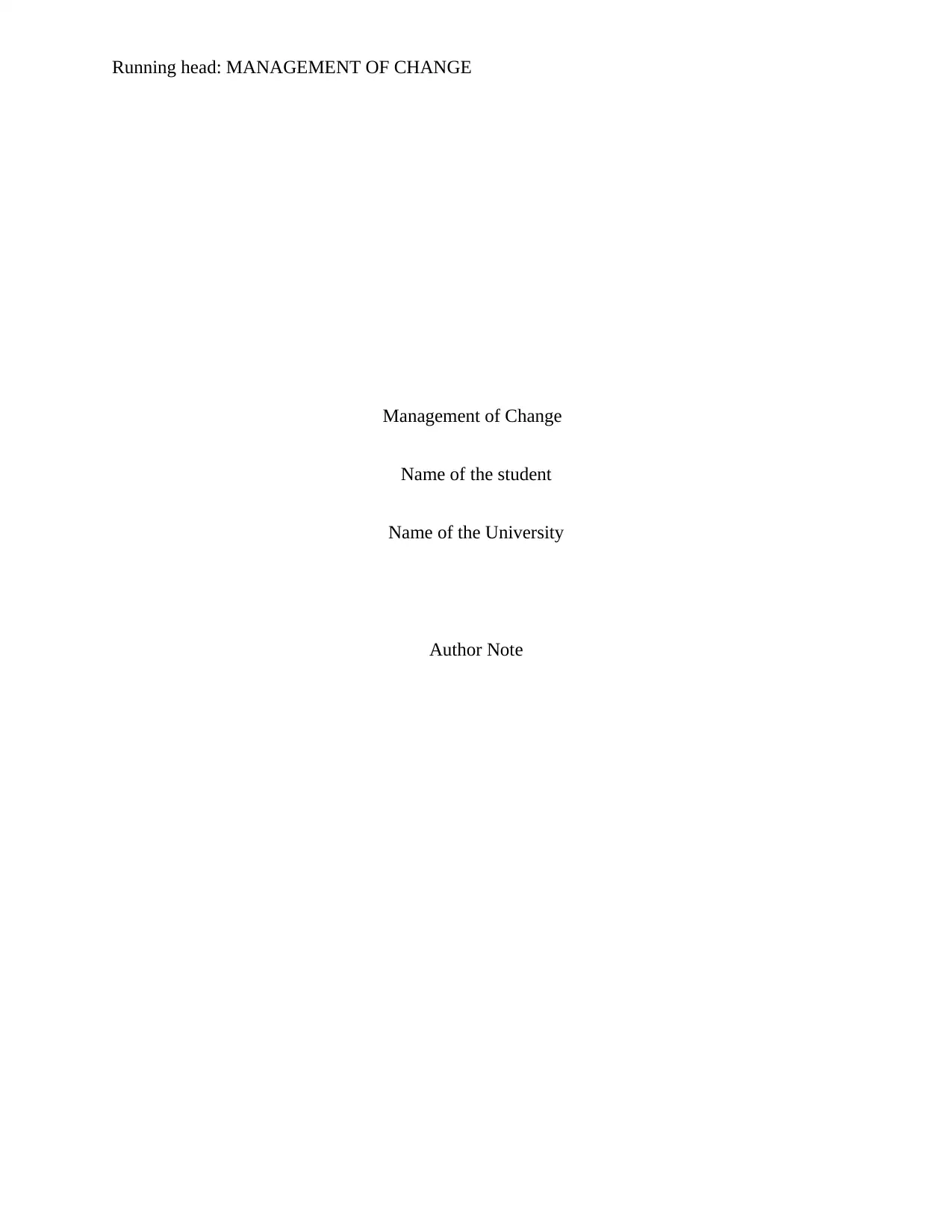
Running head: MANAGEMENT OF CHANGE
Management of Change
Name of the student
Name of the University
Author Note
Management of Change
Name of the student
Name of the University
Author Note
Paraphrase This Document
Need a fresh take? Get an instant paraphrase of this document with our AI Paraphraser
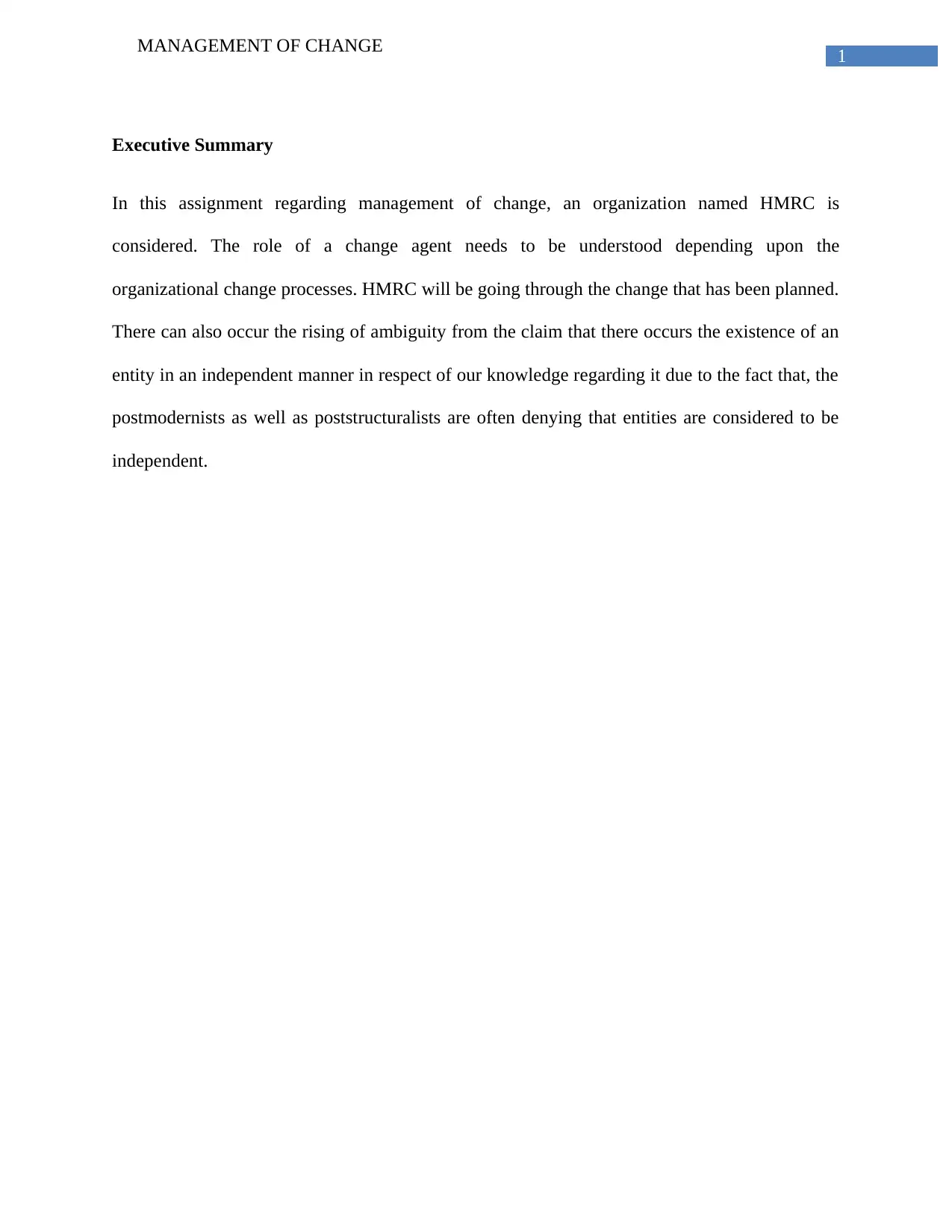
1
MANAGEMENT OF CHANGE
Executive Summary
In this assignment regarding management of change, an organization named HMRC is
considered. The role of a change agent needs to be understood depending upon the
organizational change processes. HMRC will be going through the change that has been planned.
There can also occur the rising of ambiguity from the claim that there occurs the existence of an
entity in an independent manner in respect of our knowledge regarding it due to the fact that, the
postmodernists as well as poststructuralists are often denying that entities are considered to be
independent.
MANAGEMENT OF CHANGE
Executive Summary
In this assignment regarding management of change, an organization named HMRC is
considered. The role of a change agent needs to be understood depending upon the
organizational change processes. HMRC will be going through the change that has been planned.
There can also occur the rising of ambiguity from the claim that there occurs the existence of an
entity in an independent manner in respect of our knowledge regarding it due to the fact that, the
postmodernists as well as poststructuralists are often denying that entities are considered to be
independent.
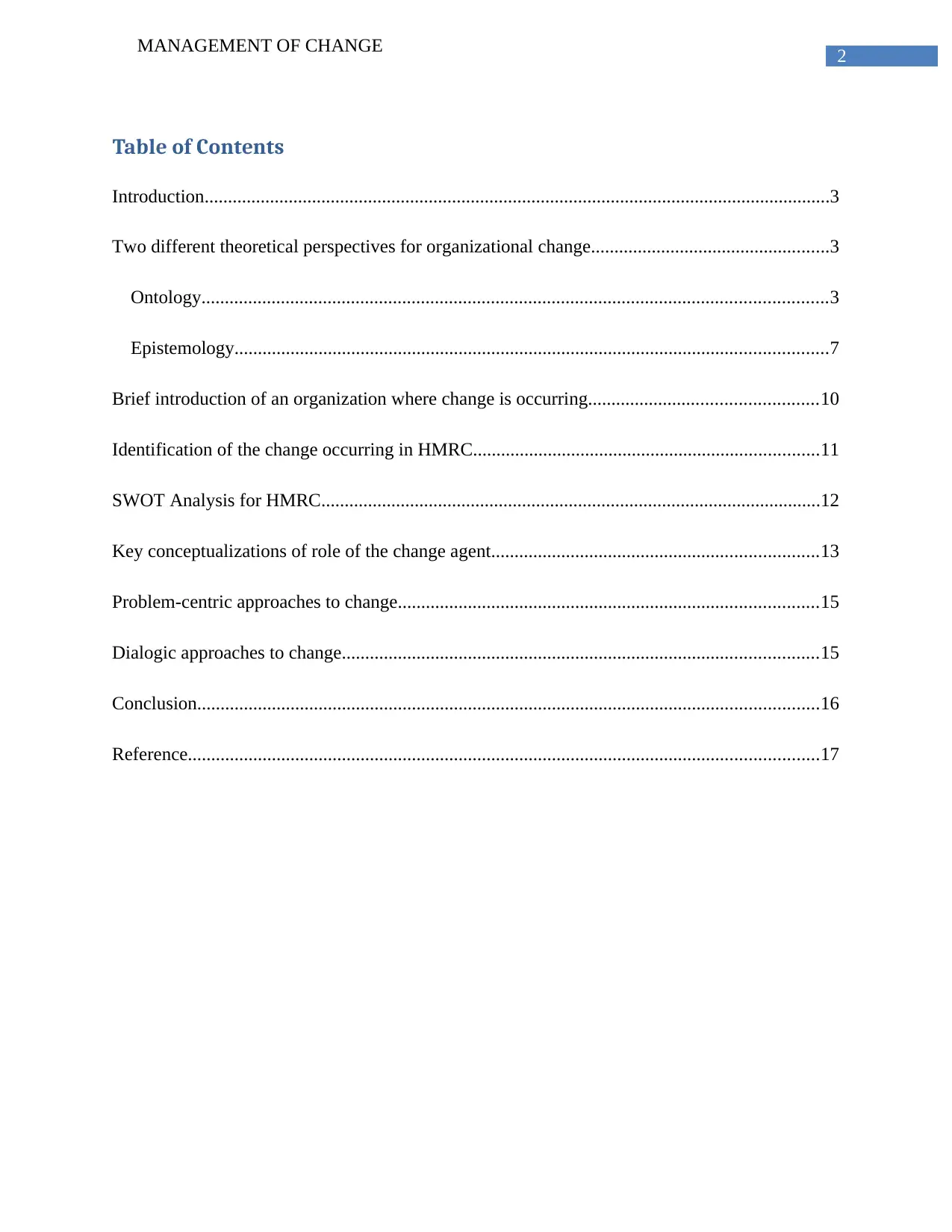
2
MANAGEMENT OF CHANGE
Table of Contents
Introduction......................................................................................................................................3
Two different theoretical perspectives for organizational change...................................................3
Ontology......................................................................................................................................3
Epistemology...............................................................................................................................7
Brief introduction of an organization where change is occurring.................................................10
Identification of the change occurring in HMRC..........................................................................11
SWOT Analysis for HMRC...........................................................................................................12
Key conceptualizations of role of the change agent......................................................................13
Problem-centric approaches to change..........................................................................................15
Dialogic approaches to change......................................................................................................15
Conclusion.....................................................................................................................................16
Reference.......................................................................................................................................17
MANAGEMENT OF CHANGE
Table of Contents
Introduction......................................................................................................................................3
Two different theoretical perspectives for organizational change...................................................3
Ontology......................................................................................................................................3
Epistemology...............................................................................................................................7
Brief introduction of an organization where change is occurring.................................................10
Identification of the change occurring in HMRC..........................................................................11
SWOT Analysis for HMRC...........................................................................................................12
Key conceptualizations of role of the change agent......................................................................13
Problem-centric approaches to change..........................................................................................15
Dialogic approaches to change......................................................................................................15
Conclusion.....................................................................................................................................16
Reference.......................................................................................................................................17
⊘ This is a preview!⊘
Do you want full access?
Subscribe today to unlock all pages.

Trusted by 1+ million students worldwide
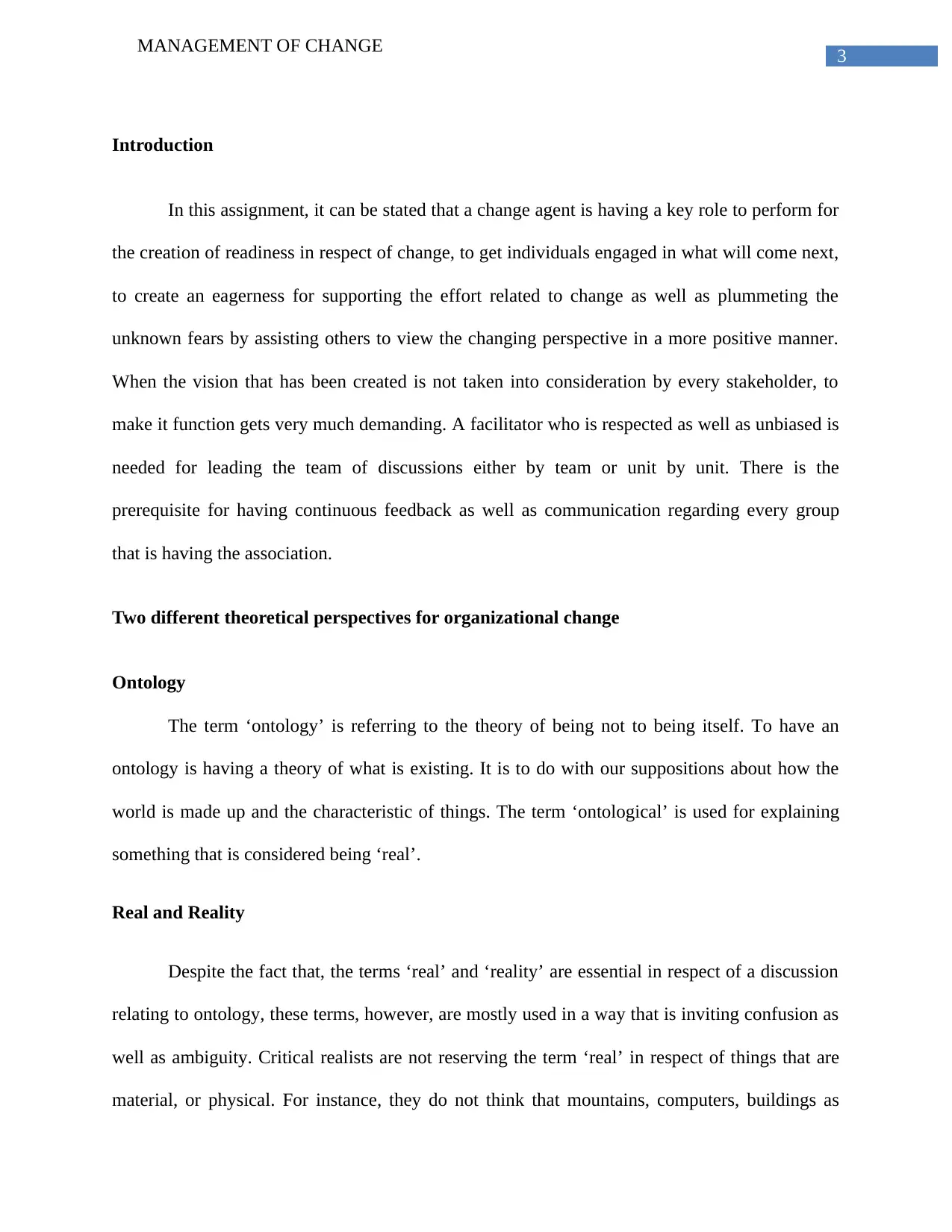
3
MANAGEMENT OF CHANGE
Introduction
In this assignment, it can be stated that a change agent is having a key role to perform for
the creation of readiness in respect of change, to get individuals engaged in what will come next,
to create an eagerness for supporting the effort related to change as well as plummeting the
unknown fears by assisting others to view the changing perspective in a more positive manner.
When the vision that has been created is not taken into consideration by every stakeholder, to
make it function gets very much demanding. A facilitator who is respected as well as unbiased is
needed for leading the team of discussions either by team or unit by unit. There is the
prerequisite for having continuous feedback as well as communication regarding every group
that is having the association.
Two different theoretical perspectives for organizational change
Ontology
The term ‘ontology’ is referring to the theory of being not to being itself. To have an
ontology is having a theory of what is existing. It is to do with our suppositions about how the
world is made up and the characteristic of things. The term ‘ontological’ is used for explaining
something that is considered being ‘real’.
Real and Reality
Despite the fact that, the terms ‘real’ and ‘reality’ are essential in respect of a discussion
relating to ontology, these terms, however, are mostly used in a way that is inviting confusion as
well as ambiguity. Critical realists are not reserving the term ‘real’ in respect of things that are
material, or physical. For instance, they do not think that mountains, computers, buildings as
MANAGEMENT OF CHANGE
Introduction
In this assignment, it can be stated that a change agent is having a key role to perform for
the creation of readiness in respect of change, to get individuals engaged in what will come next,
to create an eagerness for supporting the effort related to change as well as plummeting the
unknown fears by assisting others to view the changing perspective in a more positive manner.
When the vision that has been created is not taken into consideration by every stakeholder, to
make it function gets very much demanding. A facilitator who is respected as well as unbiased is
needed for leading the team of discussions either by team or unit by unit. There is the
prerequisite for having continuous feedback as well as communication regarding every group
that is having the association.
Two different theoretical perspectives for organizational change
Ontology
The term ‘ontology’ is referring to the theory of being not to being itself. To have an
ontology is having a theory of what is existing. It is to do with our suppositions about how the
world is made up and the characteristic of things. The term ‘ontological’ is used for explaining
something that is considered being ‘real’.
Real and Reality
Despite the fact that, the terms ‘real’ and ‘reality’ are essential in respect of a discussion
relating to ontology, these terms, however, are mostly used in a way that is inviting confusion as
well as ambiguity. Critical realists are not reserving the term ‘real’ in respect of things that are
material, or physical. For instance, they do not think that mountains, computers, buildings as
Paraphrase This Document
Need a fresh take? Get an instant paraphrase of this document with our AI Paraphraser
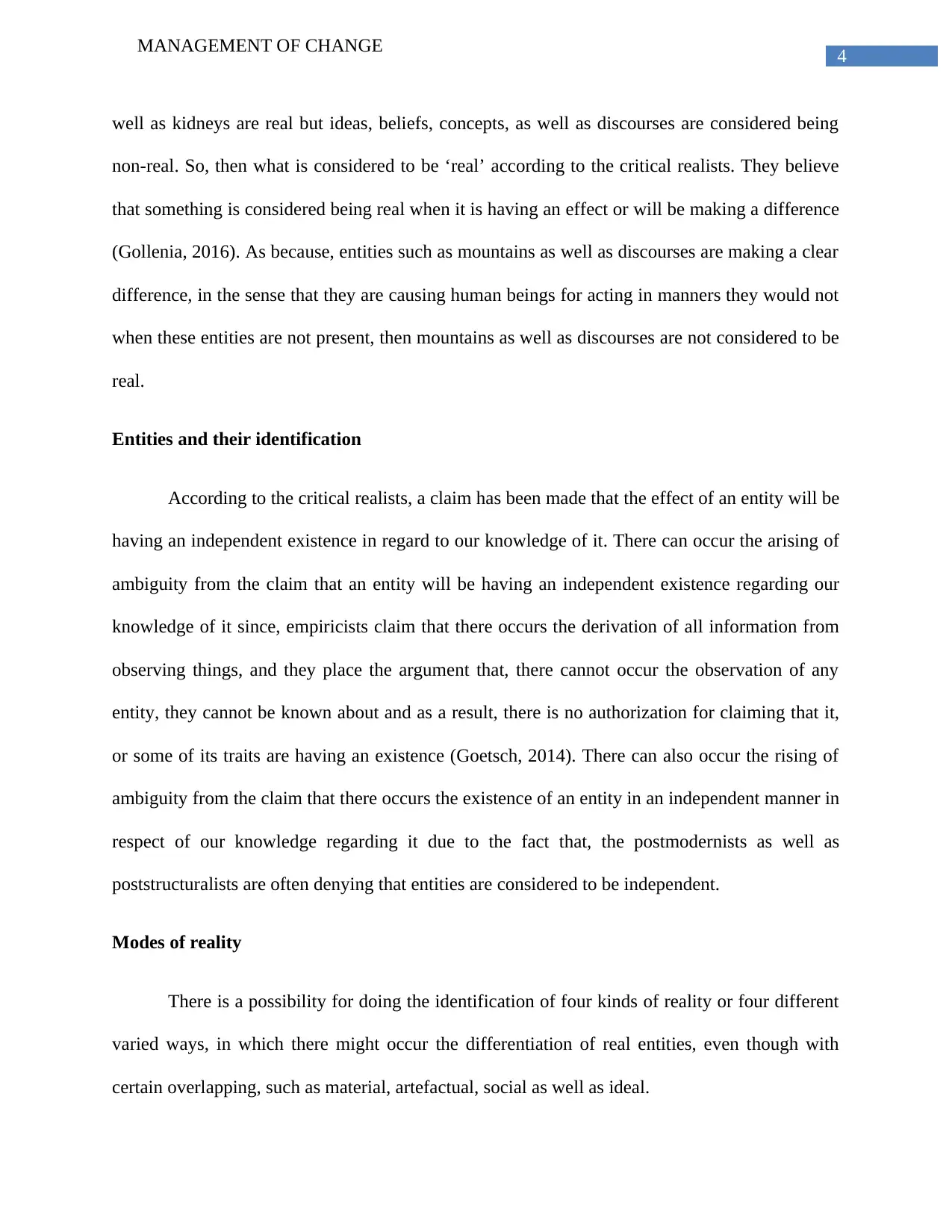
4
MANAGEMENT OF CHANGE
well as kidneys are real but ideas, beliefs, concepts, as well as discourses are considered being
non-real. So, then what is considered to be ‘real’ according to the critical realists. They believe
that something is considered being real when it is having an effect or will be making a difference
(Gollenia, 2016). As because, entities such as mountains as well as discourses are making a clear
difference, in the sense that they are causing human beings for acting in manners they would not
when these entities are not present, then mountains as well as discourses are not considered to be
real.
Entities and their identification
According to the critical realists, a claim has been made that the effect of an entity will be
having an independent existence in regard to our knowledge of it. There can occur the arising of
ambiguity from the claim that an entity will be having an independent existence regarding our
knowledge of it since, empiricists claim that there occurs the derivation of all information from
observing things, and they place the argument that, there cannot occur the observation of any
entity, they cannot be known about and as a result, there is no authorization for claiming that it,
or some of its traits are having an existence (Goetsch, 2014). There can also occur the rising of
ambiguity from the claim that there occurs the existence of an entity in an independent manner in
respect of our knowledge regarding it due to the fact that, the postmodernists as well as
poststructuralists are often denying that entities are considered to be independent.
Modes of reality
There is a possibility for doing the identification of four kinds of reality or four different
varied ways, in which there might occur the differentiation of real entities, even though with
certain overlapping, such as material, artefactual, social as well as ideal.
MANAGEMENT OF CHANGE
well as kidneys are real but ideas, beliefs, concepts, as well as discourses are considered being
non-real. So, then what is considered to be ‘real’ according to the critical realists. They believe
that something is considered being real when it is having an effect or will be making a difference
(Gollenia, 2016). As because, entities such as mountains as well as discourses are making a clear
difference, in the sense that they are causing human beings for acting in manners they would not
when these entities are not present, then mountains as well as discourses are not considered to be
real.
Entities and their identification
According to the critical realists, a claim has been made that the effect of an entity will be
having an independent existence in regard to our knowledge of it. There can occur the arising of
ambiguity from the claim that an entity will be having an independent existence regarding our
knowledge of it since, empiricists claim that there occurs the derivation of all information from
observing things, and they place the argument that, there cannot occur the observation of any
entity, they cannot be known about and as a result, there is no authorization for claiming that it,
or some of its traits are having an existence (Goetsch, 2014). There can also occur the rising of
ambiguity from the claim that there occurs the existence of an entity in an independent manner in
respect of our knowledge regarding it due to the fact that, the postmodernists as well as
poststructuralists are often denying that entities are considered to be independent.
Modes of reality
There is a possibility for doing the identification of four kinds of reality or four different
varied ways, in which there might occur the differentiation of real entities, even though with
certain overlapping, such as material, artefactual, social as well as ideal.
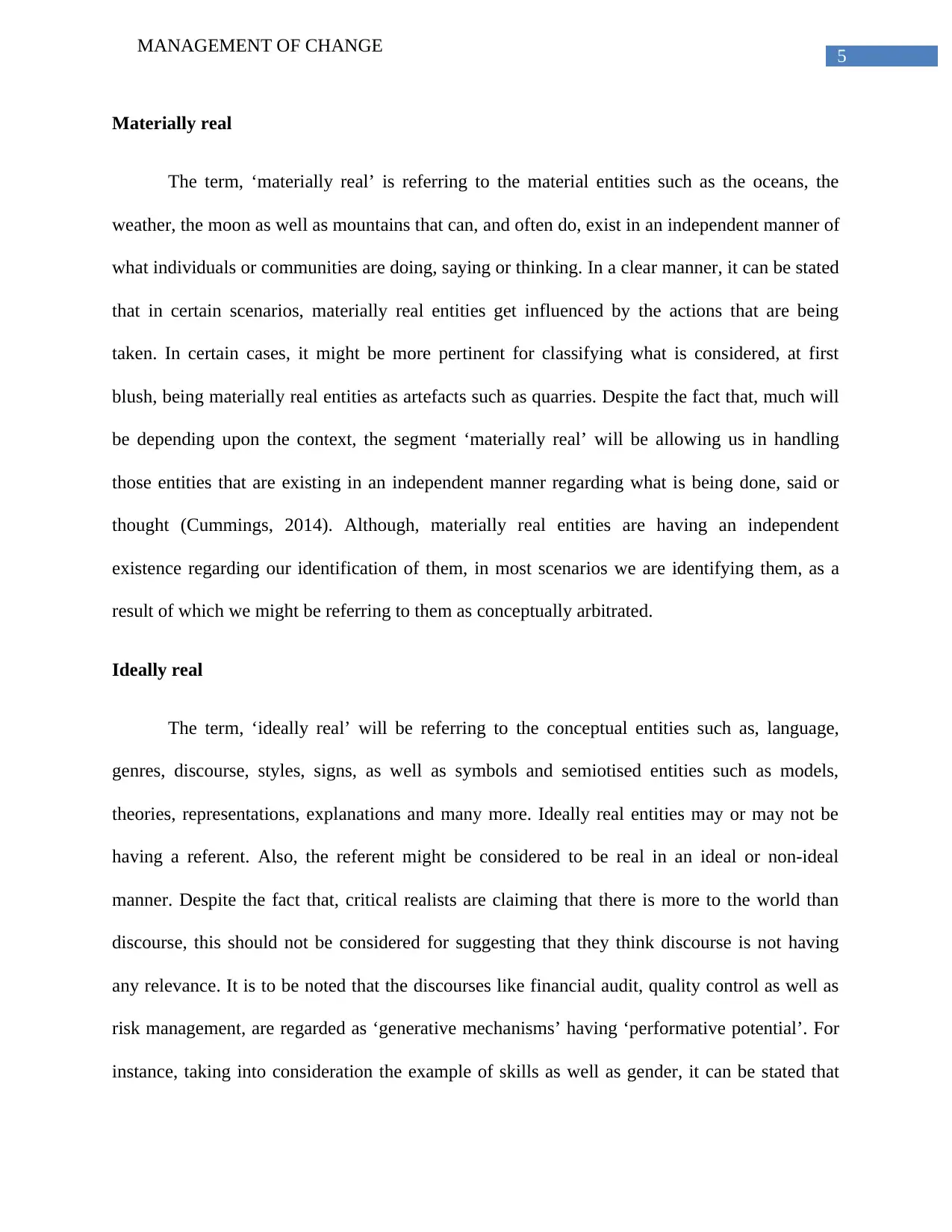
5
MANAGEMENT OF CHANGE
Materially real
The term, ‘materially real’ is referring to the material entities such as the oceans, the
weather, the moon as well as mountains that can, and often do, exist in an independent manner of
what individuals or communities are doing, saying or thinking. In a clear manner, it can be stated
that in certain scenarios, materially real entities get influenced by the actions that are being
taken. In certain cases, it might be more pertinent for classifying what is considered, at first
blush, being materially real entities as artefacts such as quarries. Despite the fact that, much will
be depending upon the context, the segment ‘materially real’ will be allowing us in handling
those entities that are existing in an independent manner regarding what is being done, said or
thought (Cummings, 2014). Although, materially real entities are having an independent
existence regarding our identification of them, in most scenarios we are identifying them, as a
result of which we might be referring to them as conceptually arbitrated.
Ideally real
The term, ‘ideally real’ will be referring to the conceptual entities such as, language,
genres, discourse, styles, signs, as well as symbols and semiotised entities such as models,
theories, representations, explanations and many more. Ideally real entities may or may not be
having a referent. Also, the referent might be considered to be real in an ideal or non-ideal
manner. Despite the fact that, critical realists are claiming that there is more to the world than
discourse, this should not be considered for suggesting that they think discourse is not having
any relevance. It is to be noted that the discourses like financial audit, quality control as well as
risk management, are regarded as ‘generative mechanisms’ having ‘performative potential’. For
instance, taking into consideration the example of skills as well as gender, it can be stated that
MANAGEMENT OF CHANGE
Materially real
The term, ‘materially real’ is referring to the material entities such as the oceans, the
weather, the moon as well as mountains that can, and often do, exist in an independent manner of
what individuals or communities are doing, saying or thinking. In a clear manner, it can be stated
that in certain scenarios, materially real entities get influenced by the actions that are being
taken. In certain cases, it might be more pertinent for classifying what is considered, at first
blush, being materially real entities as artefacts such as quarries. Despite the fact that, much will
be depending upon the context, the segment ‘materially real’ will be allowing us in handling
those entities that are existing in an independent manner regarding what is being done, said or
thought (Cummings, 2014). Although, materially real entities are having an independent
existence regarding our identification of them, in most scenarios we are identifying them, as a
result of which we might be referring to them as conceptually arbitrated.
Ideally real
The term, ‘ideally real’ will be referring to the conceptual entities such as, language,
genres, discourse, styles, signs, as well as symbols and semiotised entities such as models,
theories, representations, explanations and many more. Ideally real entities may or may not be
having a referent. Also, the referent might be considered to be real in an ideal or non-ideal
manner. Despite the fact that, critical realists are claiming that there is more to the world than
discourse, this should not be considered for suggesting that they think discourse is not having
any relevance. It is to be noted that the discourses like financial audit, quality control as well as
risk management, are regarded as ‘generative mechanisms’ having ‘performative potential’. For
instance, taking into consideration the example of skills as well as gender, it can be stated that
⊘ This is a preview!⊘
Do you want full access?
Subscribe today to unlock all pages.

Trusted by 1+ million students worldwide
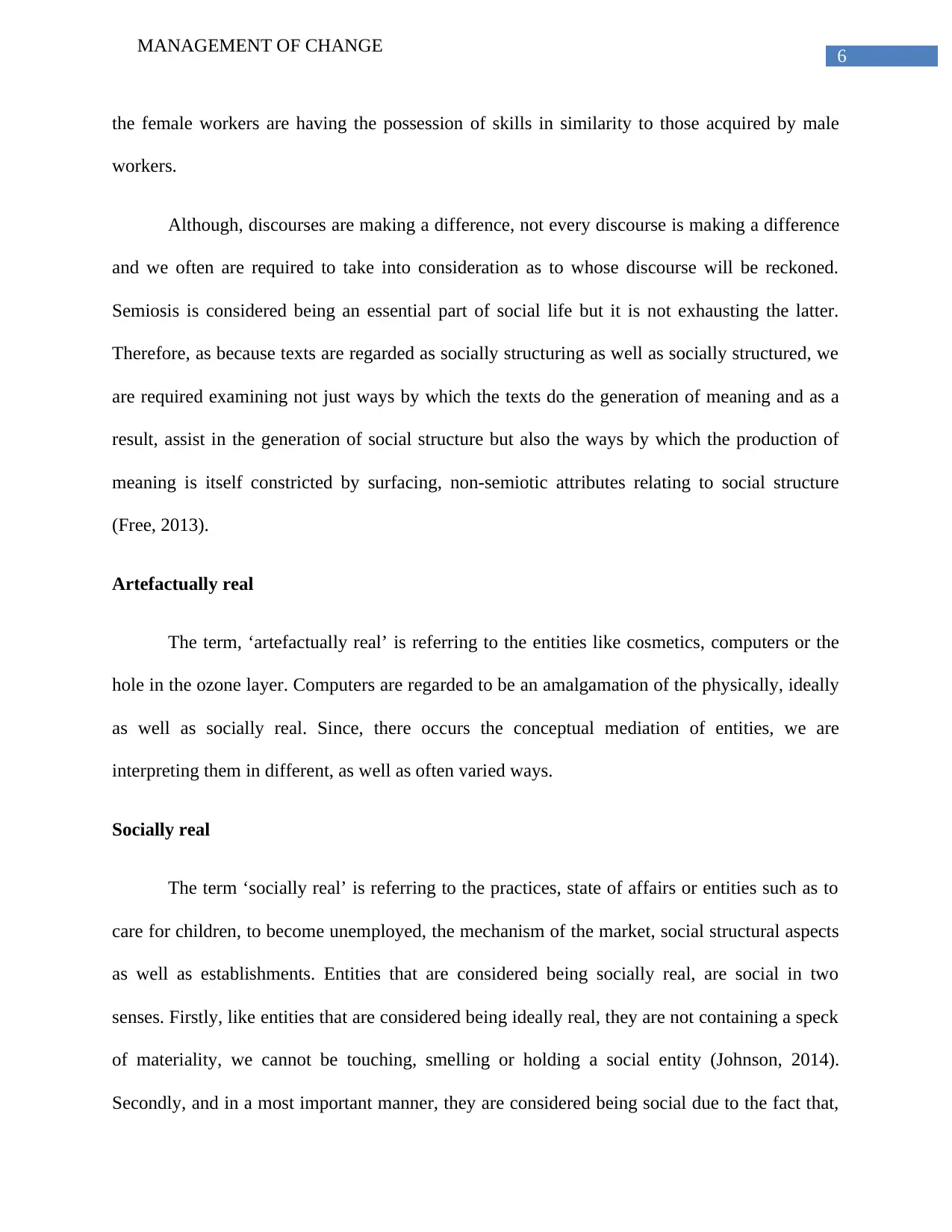
6
MANAGEMENT OF CHANGE
the female workers are having the possession of skills in similarity to those acquired by male
workers.
Although, discourses are making a difference, not every discourse is making a difference
and we often are required to take into consideration as to whose discourse will be reckoned.
Semiosis is considered being an essential part of social life but it is not exhausting the latter.
Therefore, as because texts are regarded as socially structuring as well as socially structured, we
are required examining not just ways by which the texts do the generation of meaning and as a
result, assist in the generation of social structure but also the ways by which the production of
meaning is itself constricted by surfacing, non-semiotic attributes relating to social structure
(Free, 2013).
Artefactually real
The term, ‘artefactually real’ is referring to the entities like cosmetics, computers or the
hole in the ozone layer. Computers are regarded to be an amalgamation of the physically, ideally
as well as socially real. Since, there occurs the conceptual mediation of entities, we are
interpreting them in different, as well as often varied ways.
Socially real
The term ‘socially real’ is referring to the practices, state of affairs or entities such as to
care for children, to become unemployed, the mechanism of the market, social structural aspects
as well as establishments. Entities that are considered being socially real, are social in two
senses. Firstly, like entities that are considered being ideally real, they are not containing a speck
of materiality, we cannot be touching, smelling or holding a social entity (Johnson, 2014).
Secondly, and in a most important manner, they are considered being social due to the fact that,
MANAGEMENT OF CHANGE
the female workers are having the possession of skills in similarity to those acquired by male
workers.
Although, discourses are making a difference, not every discourse is making a difference
and we often are required to take into consideration as to whose discourse will be reckoned.
Semiosis is considered being an essential part of social life but it is not exhausting the latter.
Therefore, as because texts are regarded as socially structuring as well as socially structured, we
are required examining not just ways by which the texts do the generation of meaning and as a
result, assist in the generation of social structure but also the ways by which the production of
meaning is itself constricted by surfacing, non-semiotic attributes relating to social structure
(Free, 2013).
Artefactually real
The term, ‘artefactually real’ is referring to the entities like cosmetics, computers or the
hole in the ozone layer. Computers are regarded to be an amalgamation of the physically, ideally
as well as socially real. Since, there occurs the conceptual mediation of entities, we are
interpreting them in different, as well as often varied ways.
Socially real
The term ‘socially real’ is referring to the practices, state of affairs or entities such as to
care for children, to become unemployed, the mechanism of the market, social structural aspects
as well as establishments. Entities that are considered being socially real, are social in two
senses. Firstly, like entities that are considered being ideally real, they are not containing a speck
of materiality, we cannot be touching, smelling or holding a social entity (Johnson, 2014).
Secondly, and in a most important manner, they are considered being social due to the fact that,
Paraphrase This Document
Need a fresh take? Get an instant paraphrase of this document with our AI Paraphraser
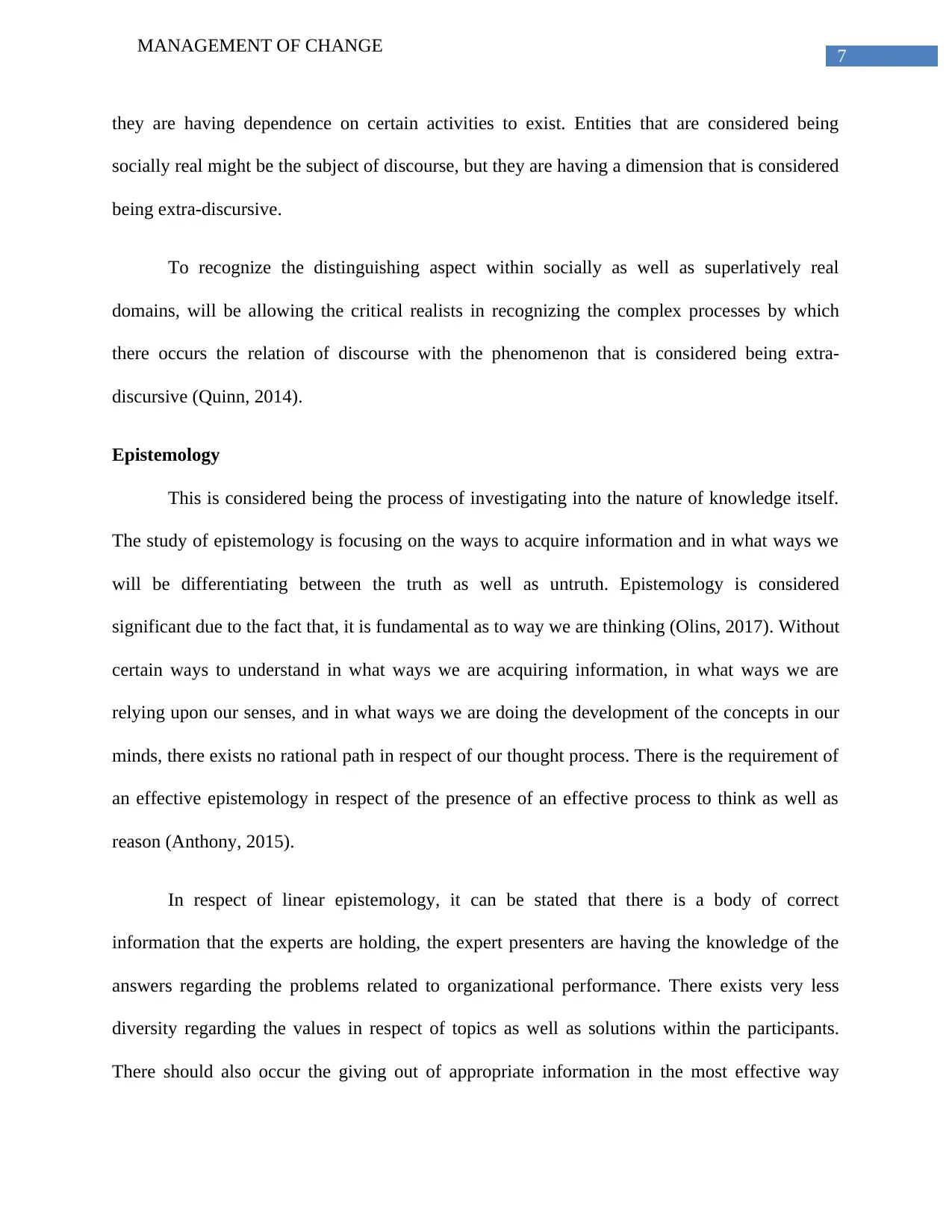
7
MANAGEMENT OF CHANGE
they are having dependence on certain activities to exist. Entities that are considered being
socially real might be the subject of discourse, but they are having a dimension that is considered
being extra-discursive.
To recognize the distinguishing aspect within socially as well as superlatively real
domains, will be allowing the critical realists in recognizing the complex processes by which
there occurs the relation of discourse with the phenomenon that is considered being extra-
discursive (Quinn, 2014).
Epistemology
This is considered being the process of investigating into the nature of knowledge itself.
The study of epistemology is focusing on the ways to acquire information and in what ways we
will be differentiating between the truth as well as untruth. Epistemology is considered
significant due to the fact that, it is fundamental as to way we are thinking (Olins, 2017). Without
certain ways to understand in what ways we are acquiring information, in what ways we are
relying upon our senses, and in what ways we are doing the development of the concepts in our
minds, there exists no rational path in respect of our thought process. There is the requirement of
an effective epistemology in respect of the presence of an effective process to think as well as
reason (Anthony, 2015).
In respect of linear epistemology, it can be stated that there is a body of correct
information that the experts are holding, the expert presenters are having the knowledge of the
answers regarding the problems related to organizational performance. There exists very less
diversity regarding the values in respect of topics as well as solutions within the participants.
There should also occur the giving out of appropriate information in the most effective way
MANAGEMENT OF CHANGE
they are having dependence on certain activities to exist. Entities that are considered being
socially real might be the subject of discourse, but they are having a dimension that is considered
being extra-discursive.
To recognize the distinguishing aspect within socially as well as superlatively real
domains, will be allowing the critical realists in recognizing the complex processes by which
there occurs the relation of discourse with the phenomenon that is considered being extra-
discursive (Quinn, 2014).
Epistemology
This is considered being the process of investigating into the nature of knowledge itself.
The study of epistemology is focusing on the ways to acquire information and in what ways we
will be differentiating between the truth as well as untruth. Epistemology is considered
significant due to the fact that, it is fundamental as to way we are thinking (Olins, 2017). Without
certain ways to understand in what ways we are acquiring information, in what ways we are
relying upon our senses, and in what ways we are doing the development of the concepts in our
minds, there exists no rational path in respect of our thought process. There is the requirement of
an effective epistemology in respect of the presence of an effective process to think as well as
reason (Anthony, 2015).
In respect of linear epistemology, it can be stated that there is a body of correct
information that the experts are holding, the expert presenters are having the knowledge of the
answers regarding the problems related to organizational performance. There exists very less
diversity regarding the values in respect of topics as well as solutions within the participants.
There should also occur the giving out of appropriate information in the most effective way
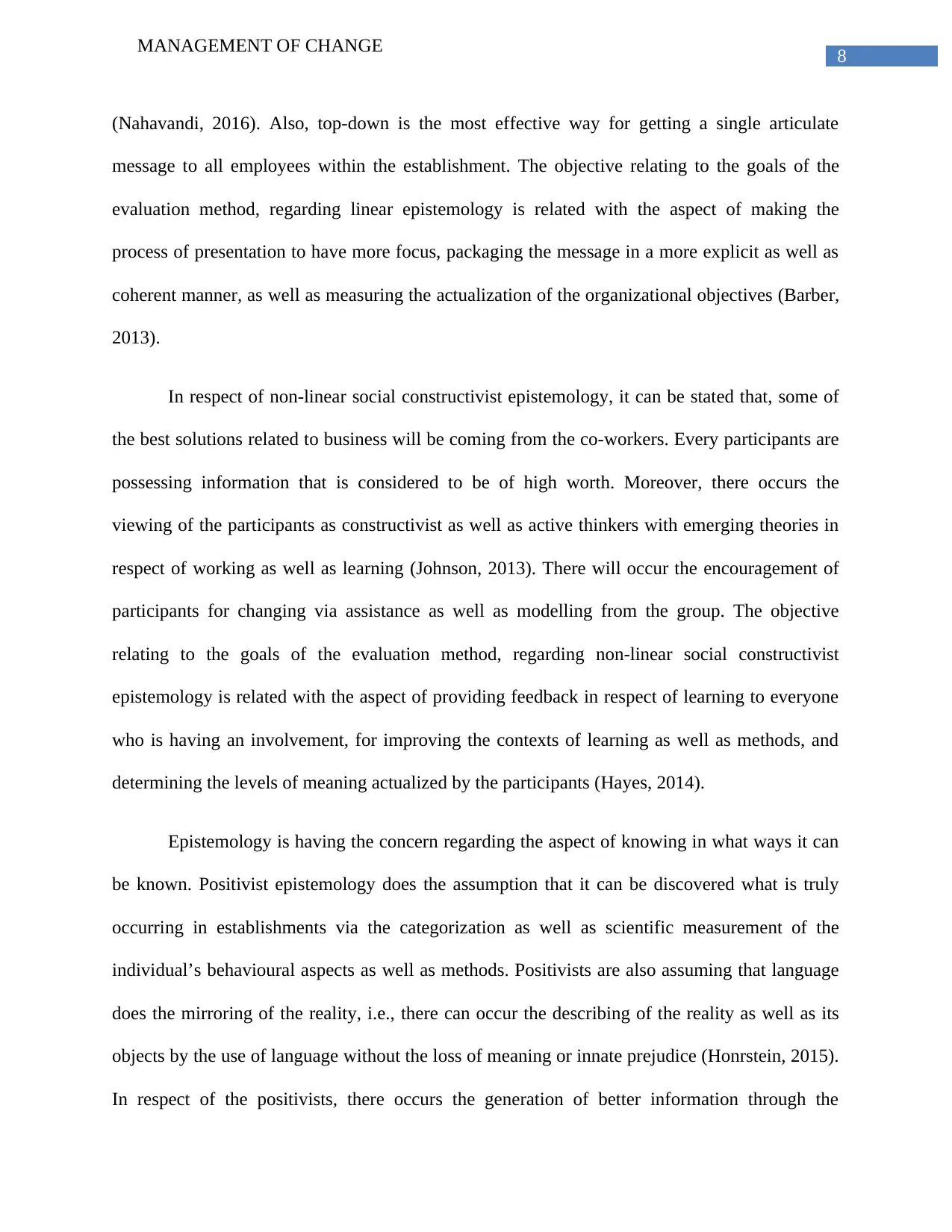
8
MANAGEMENT OF CHANGE
(Nahavandi, 2016). Also, top-down is the most effective way for getting a single articulate
message to all employees within the establishment. The objective relating to the goals of the
evaluation method, regarding linear epistemology is related with the aspect of making the
process of presentation to have more focus, packaging the message in a more explicit as well as
coherent manner, as well as measuring the actualization of the organizational objectives (Barber,
2013).
In respect of non-linear social constructivist epistemology, it can be stated that, some of
the best solutions related to business will be coming from the co-workers. Every participants are
possessing information that is considered to be of high worth. Moreover, there occurs the
viewing of the participants as constructivist as well as active thinkers with emerging theories in
respect of working as well as learning (Johnson, 2013). There will occur the encouragement of
participants for changing via assistance as well as modelling from the group. The objective
relating to the goals of the evaluation method, regarding non-linear social constructivist
epistemology is related with the aspect of providing feedback in respect of learning to everyone
who is having an involvement, for improving the contexts of learning as well as methods, and
determining the levels of meaning actualized by the participants (Hayes, 2014).
Epistemology is having the concern regarding the aspect of knowing in what ways it can
be known. Positivist epistemology does the assumption that it can be discovered what is truly
occurring in establishments via the categorization as well as scientific measurement of the
individual’s behavioural aspects as well as methods. Positivists are also assuming that language
does the mirroring of the reality, i.e., there can occur the describing of the reality as well as its
objects by the use of language without the loss of meaning or innate prejudice (Honrstein, 2015).
In respect of the positivists, there occurs the generation of better information through the
MANAGEMENT OF CHANGE
(Nahavandi, 2016). Also, top-down is the most effective way for getting a single articulate
message to all employees within the establishment. The objective relating to the goals of the
evaluation method, regarding linear epistemology is related with the aspect of making the
process of presentation to have more focus, packaging the message in a more explicit as well as
coherent manner, as well as measuring the actualization of the organizational objectives (Barber,
2013).
In respect of non-linear social constructivist epistemology, it can be stated that, some of
the best solutions related to business will be coming from the co-workers. Every participants are
possessing information that is considered to be of high worth. Moreover, there occurs the
viewing of the participants as constructivist as well as active thinkers with emerging theories in
respect of working as well as learning (Johnson, 2013). There will occur the encouragement of
participants for changing via assistance as well as modelling from the group. The objective
relating to the goals of the evaluation method, regarding non-linear social constructivist
epistemology is related with the aspect of providing feedback in respect of learning to everyone
who is having an involvement, for improving the contexts of learning as well as methods, and
determining the levels of meaning actualized by the participants (Hayes, 2014).
Epistemology is having the concern regarding the aspect of knowing in what ways it can
be known. Positivist epistemology does the assumption that it can be discovered what is truly
occurring in establishments via the categorization as well as scientific measurement of the
individual’s behavioural aspects as well as methods. Positivists are also assuming that language
does the mirroring of the reality, i.e., there can occur the describing of the reality as well as its
objects by the use of language without the loss of meaning or innate prejudice (Honrstein, 2015).
In respect of the positivists, there occurs the generation of better information through the
⊘ This is a preview!⊘
Do you want full access?
Subscribe today to unlock all pages.

Trusted by 1+ million students worldwide
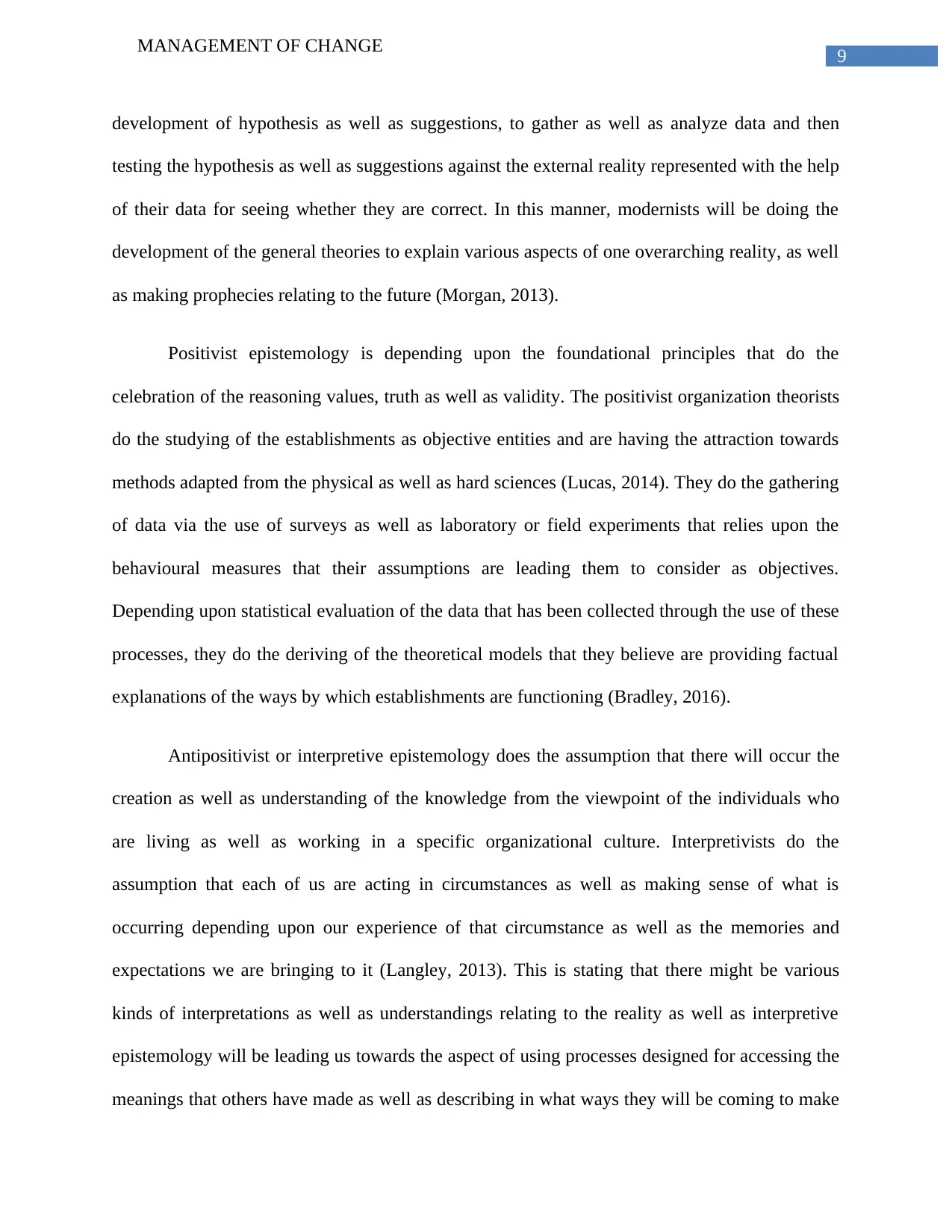
9
MANAGEMENT OF CHANGE
development of hypothesis as well as suggestions, to gather as well as analyze data and then
testing the hypothesis as well as suggestions against the external reality represented with the help
of their data for seeing whether they are correct. In this manner, modernists will be doing the
development of the general theories to explain various aspects of one overarching reality, as well
as making prophecies relating to the future (Morgan, 2013).
Positivist epistemology is depending upon the foundational principles that do the
celebration of the reasoning values, truth as well as validity. The positivist organization theorists
do the studying of the establishments as objective entities and are having the attraction towards
methods adapted from the physical as well as hard sciences (Lucas, 2014). They do the gathering
of data via the use of surveys as well as laboratory or field experiments that relies upon the
behavioural measures that their assumptions are leading them to consider as objectives.
Depending upon statistical evaluation of the data that has been collected through the use of these
processes, they do the deriving of the theoretical models that they believe are providing factual
explanations of the ways by which establishments are functioning (Bradley, 2016).
Antipositivist or interpretive epistemology does the assumption that there will occur the
creation as well as understanding of the knowledge from the viewpoint of the individuals who
are living as well as working in a specific organizational culture. Interpretivists do the
assumption that each of us are acting in circumstances as well as making sense of what is
occurring depending upon our experience of that circumstance as well as the memories and
expectations we are bringing to it (Langley, 2013). This is stating that there might be various
kinds of interpretations as well as understandings relating to the reality as well as interpretive
epistemology will be leading us towards the aspect of using processes designed for accessing the
meanings that others have made as well as describing in what ways they will be coming to make
MANAGEMENT OF CHANGE
development of hypothesis as well as suggestions, to gather as well as analyze data and then
testing the hypothesis as well as suggestions against the external reality represented with the help
of their data for seeing whether they are correct. In this manner, modernists will be doing the
development of the general theories to explain various aspects of one overarching reality, as well
as making prophecies relating to the future (Morgan, 2013).
Positivist epistemology is depending upon the foundational principles that do the
celebration of the reasoning values, truth as well as validity. The positivist organization theorists
do the studying of the establishments as objective entities and are having the attraction towards
methods adapted from the physical as well as hard sciences (Lucas, 2014). They do the gathering
of data via the use of surveys as well as laboratory or field experiments that relies upon the
behavioural measures that their assumptions are leading them to consider as objectives.
Depending upon statistical evaluation of the data that has been collected through the use of these
processes, they do the deriving of the theoretical models that they believe are providing factual
explanations of the ways by which establishments are functioning (Bradley, 2016).
Antipositivist or interpretive epistemology does the assumption that there will occur the
creation as well as understanding of the knowledge from the viewpoint of the individuals who
are living as well as working in a specific organizational culture. Interpretivists do the
assumption that each of us are acting in circumstances as well as making sense of what is
occurring depending upon our experience of that circumstance as well as the memories and
expectations we are bringing to it (Langley, 2013). This is stating that there might be various
kinds of interpretations as well as understandings relating to the reality as well as interpretive
epistemology will be leading us towards the aspect of using processes designed for accessing the
meanings that others have made as well as describing in what ways they will be coming to make
Paraphrase This Document
Need a fresh take? Get an instant paraphrase of this document with our AI Paraphraser
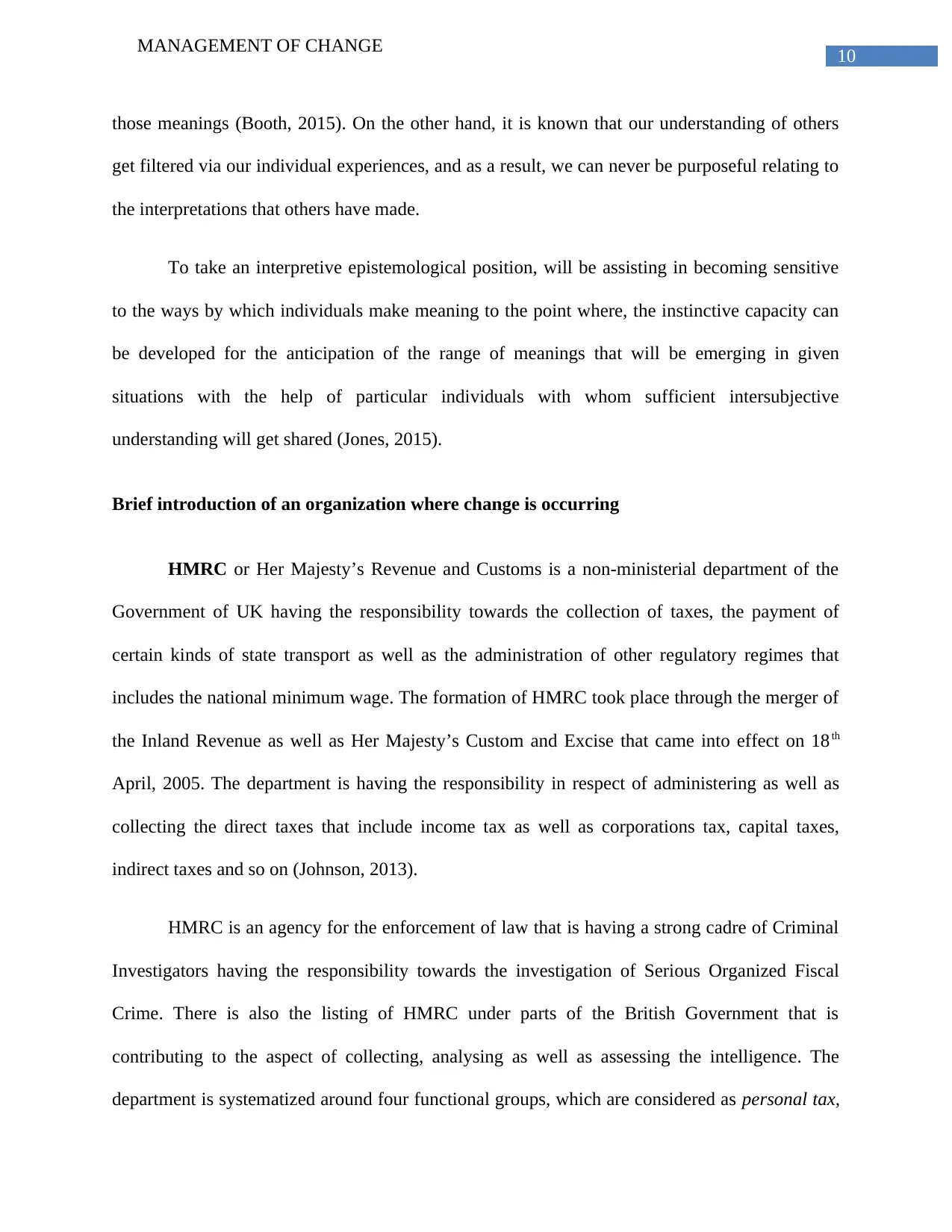
10
MANAGEMENT OF CHANGE
those meanings (Booth, 2015). On the other hand, it is known that our understanding of others
get filtered via our individual experiences, and as a result, we can never be purposeful relating to
the interpretations that others have made.
To take an interpretive epistemological position, will be assisting in becoming sensitive
to the ways by which individuals make meaning to the point where, the instinctive capacity can
be developed for the anticipation of the range of meanings that will be emerging in given
situations with the help of particular individuals with whom sufficient intersubjective
understanding will get shared (Jones, 2015).
Brief introduction of an organization where change is occurring
HMRC or Her Majesty’s Revenue and Customs is a non-ministerial department of the
Government of UK having the responsibility towards the collection of taxes, the payment of
certain kinds of state transport as well as the administration of other regulatory regimes that
includes the national minimum wage. The formation of HMRC took place through the merger of
the Inland Revenue as well as Her Majesty’s Custom and Excise that came into effect on 18th
April, 2005. The department is having the responsibility in respect of administering as well as
collecting the direct taxes that include income tax as well as corporations tax, capital taxes,
indirect taxes and so on (Johnson, 2013).
HMRC is an agency for the enforcement of law that is having a strong cadre of Criminal
Investigators having the responsibility towards the investigation of Serious Organized Fiscal
Crime. There is also the listing of HMRC under parts of the British Government that is
contributing to the aspect of collecting, analysing as well as assessing the intelligence. The
department is systematized around four functional groups, which are considered as personal tax,
MANAGEMENT OF CHANGE
those meanings (Booth, 2015). On the other hand, it is known that our understanding of others
get filtered via our individual experiences, and as a result, we can never be purposeful relating to
the interpretations that others have made.
To take an interpretive epistemological position, will be assisting in becoming sensitive
to the ways by which individuals make meaning to the point where, the instinctive capacity can
be developed for the anticipation of the range of meanings that will be emerging in given
situations with the help of particular individuals with whom sufficient intersubjective
understanding will get shared (Jones, 2015).
Brief introduction of an organization where change is occurring
HMRC or Her Majesty’s Revenue and Customs is a non-ministerial department of the
Government of UK having the responsibility towards the collection of taxes, the payment of
certain kinds of state transport as well as the administration of other regulatory regimes that
includes the national minimum wage. The formation of HMRC took place through the merger of
the Inland Revenue as well as Her Majesty’s Custom and Excise that came into effect on 18th
April, 2005. The department is having the responsibility in respect of administering as well as
collecting the direct taxes that include income tax as well as corporations tax, capital taxes,
indirect taxes and so on (Johnson, 2013).
HMRC is an agency for the enforcement of law that is having a strong cadre of Criminal
Investigators having the responsibility towards the investigation of Serious Organized Fiscal
Crime. There is also the listing of HMRC under parts of the British Government that is
contributing to the aspect of collecting, analysing as well as assessing the intelligence. The
department is systematized around four functional groups, which are considered as personal tax,
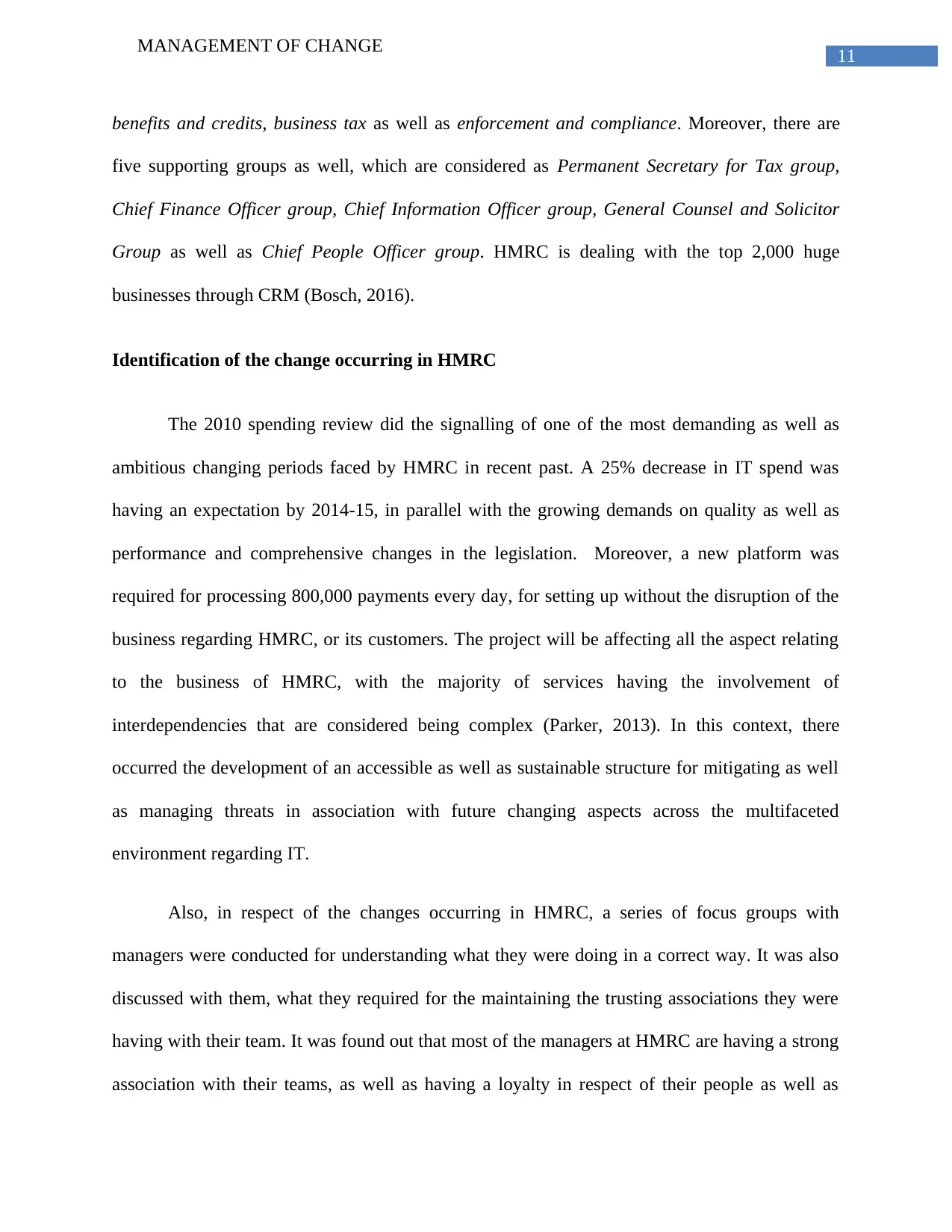
11
MANAGEMENT OF CHANGE
benefits and credits, business tax as well as enforcement and compliance. Moreover, there are
five supporting groups as well, which are considered as Permanent Secretary for Tax group,
Chief Finance Officer group, Chief Information Officer group, General Counsel and Solicitor
Group as well as Chief People Officer group. HMRC is dealing with the top 2,000 huge
businesses through CRM (Bosch, 2016).
Identification of the change occurring in HMRC
The 2010 spending review did the signalling of one of the most demanding as well as
ambitious changing periods faced by HMRC in recent past. A 25% decrease in IT spend was
having an expectation by 2014-15, in parallel with the growing demands on quality as well as
performance and comprehensive changes in the legislation. Moreover, a new platform was
required for processing 800,000 payments every day, for setting up without the disruption of the
business regarding HMRC, or its customers. The project will be affecting all the aspect relating
to the business of HMRC, with the majority of services having the involvement of
interdependencies that are considered being complex (Parker, 2013). In this context, there
occurred the development of an accessible as well as sustainable structure for mitigating as well
as managing threats in association with future changing aspects across the multifaceted
environment regarding IT.
Also, in respect of the changes occurring in HMRC, a series of focus groups with
managers were conducted for understanding what they were doing in a correct way. It was also
discussed with them, what they required for the maintaining the trusting associations they were
having with their team. It was found out that most of the managers at HMRC are having a strong
association with their teams, as well as having a loyalty in respect of their people as well as
MANAGEMENT OF CHANGE
benefits and credits, business tax as well as enforcement and compliance. Moreover, there are
five supporting groups as well, which are considered as Permanent Secretary for Tax group,
Chief Finance Officer group, Chief Information Officer group, General Counsel and Solicitor
Group as well as Chief People Officer group. HMRC is dealing with the top 2,000 huge
businesses through CRM (Bosch, 2016).
Identification of the change occurring in HMRC
The 2010 spending review did the signalling of one of the most demanding as well as
ambitious changing periods faced by HMRC in recent past. A 25% decrease in IT spend was
having an expectation by 2014-15, in parallel with the growing demands on quality as well as
performance and comprehensive changes in the legislation. Moreover, a new platform was
required for processing 800,000 payments every day, for setting up without the disruption of the
business regarding HMRC, or its customers. The project will be affecting all the aspect relating
to the business of HMRC, with the majority of services having the involvement of
interdependencies that are considered being complex (Parker, 2013). In this context, there
occurred the development of an accessible as well as sustainable structure for mitigating as well
as managing threats in association with future changing aspects across the multifaceted
environment regarding IT.
Also, in respect of the changes occurring in HMRC, a series of focus groups with
managers were conducted for understanding what they were doing in a correct way. It was also
discussed with them, what they required for the maintaining the trusting associations they were
having with their team. It was found out that most of the managers at HMRC are having a strong
association with their teams, as well as having a loyalty in respect of their people as well as
⊘ This is a preview!⊘
Do you want full access?
Subscribe today to unlock all pages.

Trusted by 1+ million students worldwide
1 out of 21
Related Documents
Your All-in-One AI-Powered Toolkit for Academic Success.
+13062052269
info@desklib.com
Available 24*7 on WhatsApp / Email
![[object Object]](/_next/static/media/star-bottom.7253800d.svg)
Unlock your academic potential
Copyright © 2020–2025 A2Z Services. All Rights Reserved. Developed and managed by ZUCOL.





